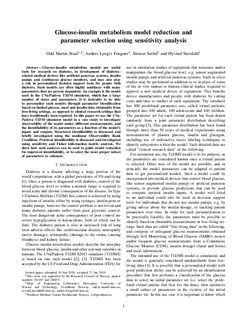| dc.contributor.author | Staal, Odd Martin | |
| dc.contributor.author | Fougner, Anders Lyngvi | |
| dc.contributor.author | Sælid, Steinar | |
| dc.contributor.author | Stavdahl, Øyvind | |
| dc.date.accessioned | 2020-01-03T12:47:01Z | |
| dc.date.available | 2020-01-03T12:47:01Z | |
| dc.date.created | 2019-07-24T12:55:49Z | |
| dc.date.issued | 2019 | |
| dc.identifier.citation | American Control Conference (ACC). 2019, 2019-July 4104-4111. | nb_NO |
| dc.identifier.issn | 0743-1619 | |
| dc.identifier.uri | http://hdl.handle.net/11250/2634807 | |
| dc.description.abstract | Glucose-insulin metabolism models are useful tools for research on diabetes, in development of diabetes-related medical devices like artificial pancreas systems, insulin pumps and continuous glucose monitors, and may also play a role in personalized decision support tools for people with diabetes. Such models are often highly nonlinear with many parameters that are person dependent. An example is the model used in the UVa/Padova T1DM simulator, which has a large number of states and parameters. It is desirable to be able to personalize such models through parameter identification based on limited glucose, meal and insulin data obtainable from free-living settings, as opposed to clinical research settings that have traditionally been required. In this paper we use the UVa-Padova T1DM simulator model in a case study to investigate observability of the model under different measurements, and the identifiability of its parameters as a function of the model's inputs and outputs. Structural identifiability is discussed and briefly investigated using the nonlinear Observability Rank Condition. Practical identifiability is discussed and investigated using sensitivity and Fisher information matrix analysis. We show how such analyses can be used to guide model reduction for improved identifiability, or to select the most proper subset of parameters to estimate. | nb_NO |
| dc.language.iso | eng | nb_NO |
| dc.publisher | Institute of Electrical and Electronics Engineers (IEEE) | nb_NO |
| dc.relation.uri | https://ieeexplore.ieee.org/document/8814949 | |
| dc.subject | Diabetes | nb_NO |
| dc.subject | Modellreduksjon | nb_NO |
| dc.subject | Reduction of models | nb_NO |
| dc.subject | Kunstig bukspyttkjertel | nb_NO |
| dc.subject | Artificial Pancreas | nb_NO |
| dc.subject | Systemidentifikasjon | nb_NO |
| dc.subject | System identification | nb_NO |
| dc.title | Glucose-insulin metabolism model reduction and parameter selection using sensitivity analysis | nb_NO |
| dc.type | Journal article | nb_NO |
| dc.type | Peer reviewed | nb_NO |
| dc.description.version | acceptedVersion | nb_NO |
| dc.subject.nsi | VDP::Medisinsk teknologi: 620 | nb_NO |
| dc.subject.nsi | VDP::Medical technology: 620 | nb_NO |
| dc.source.pagenumber | 4104-4111 | nb_NO |
| dc.source.volume | 2019-July | nb_NO |
| dc.source.journal | American Control Conference (ACC) | nb_NO |
| dc.identifier.doi | 10.23919/ACC.2019.8814949 | |
| dc.identifier.cristin | 1712586 | |
| dc.relation.project | Norges forskningsråd: 242167 | nb_NO |
| dc.description.localcode | © 2019 IEEE. Personal use of this material is permitted. Permission from IEEE must be obtained for all other uses, in any current or future media, including reprinting/republishing this material for advertising or promotional purposes, creating new collective works, for resale or redistribution to servers or lists, or reuse of any copyrighted component of this work in other works. | nb_NO |
| cristin.unitcode | 194,63,25,0 | |
| cristin.unitname | Institutt for teknisk kybernetikk | |
| cristin.ispublished | true | |
| cristin.fulltext | preprint | |
| cristin.fulltext | postprint | |
| cristin.fulltext | original | |
| cristin.qualitycode | 1 | |
